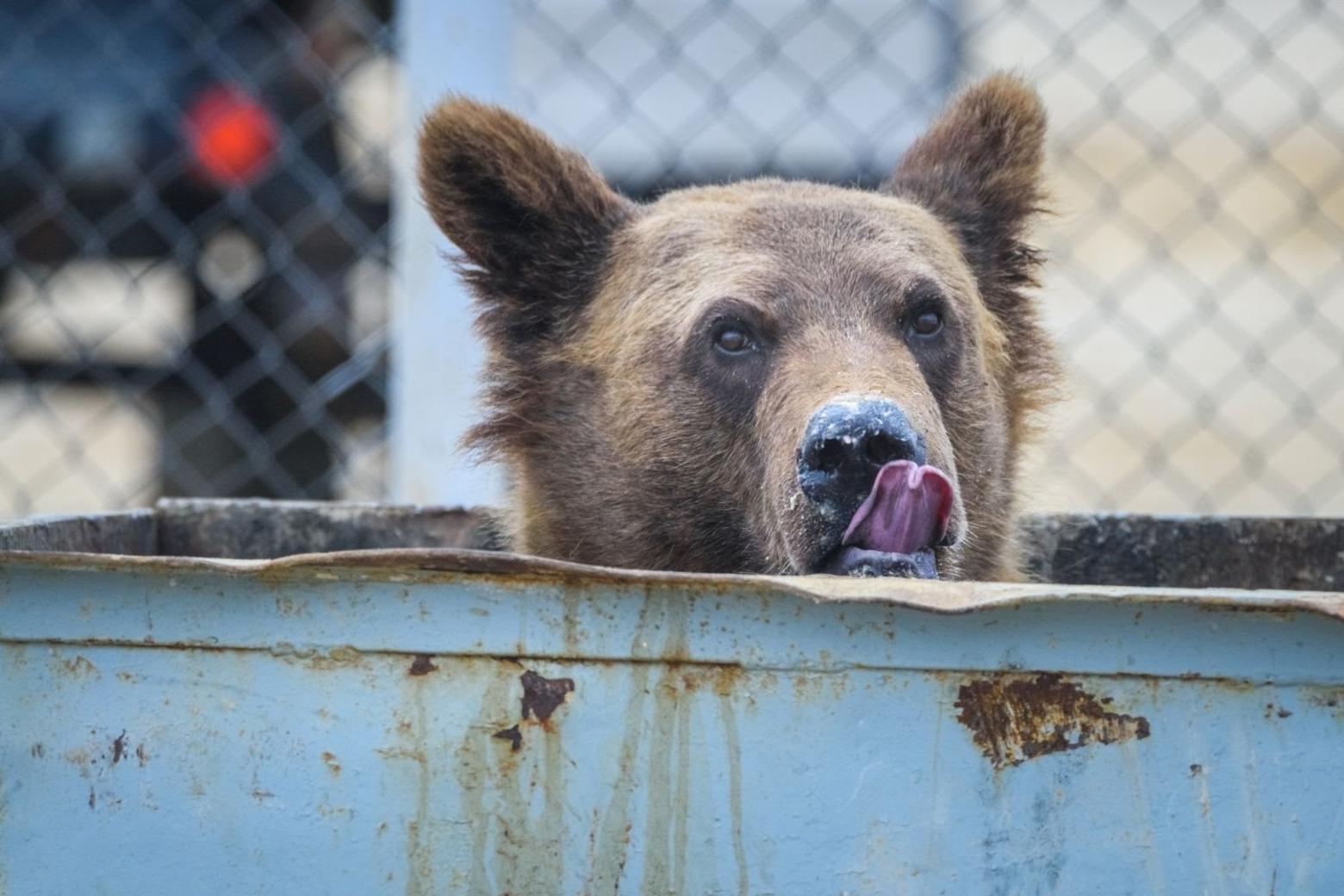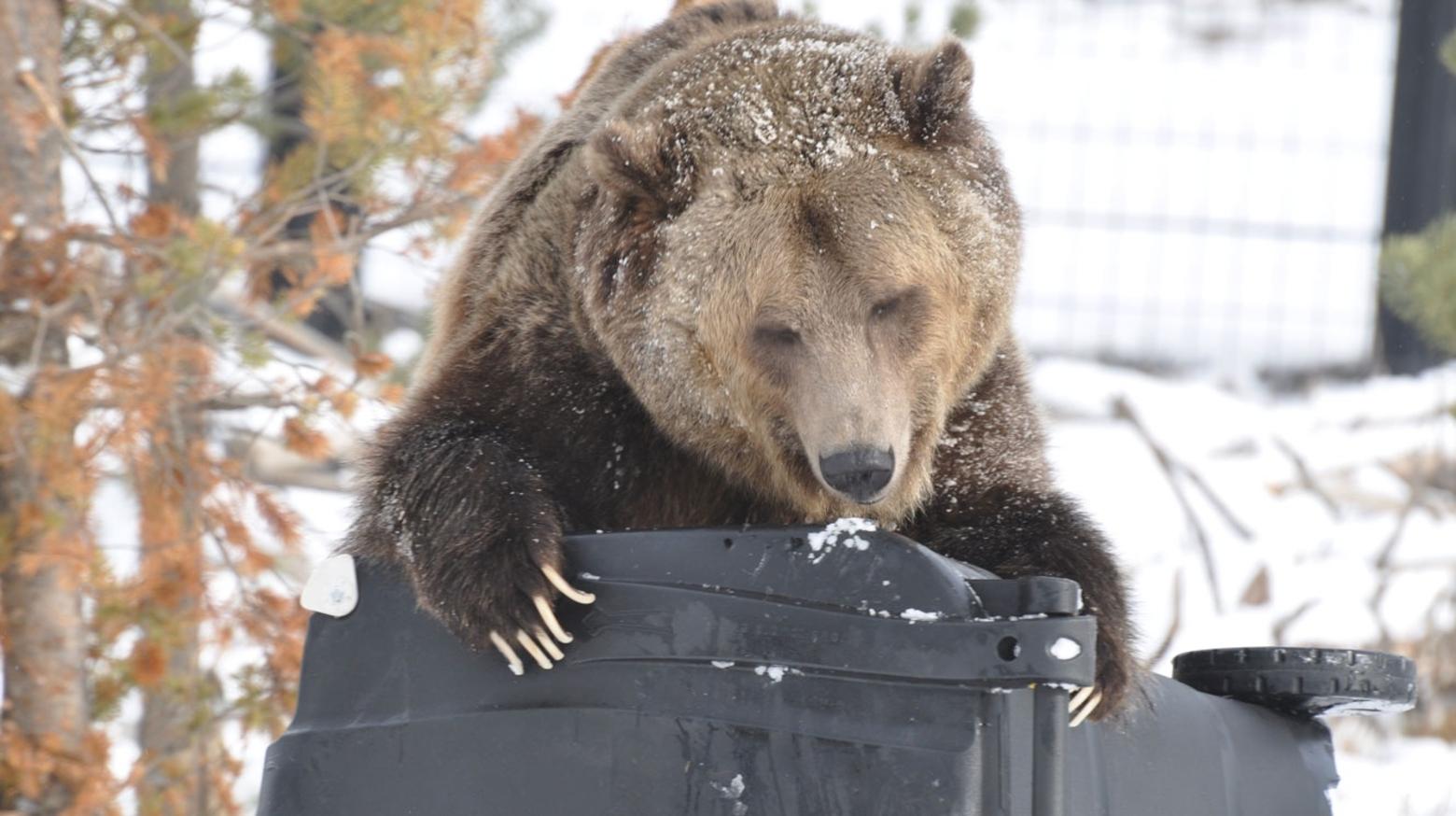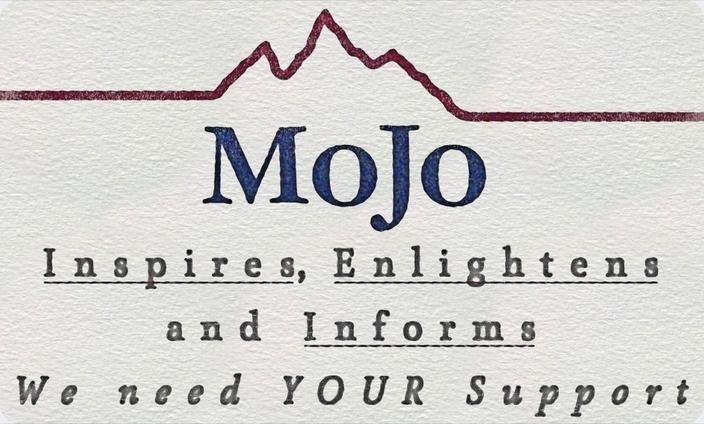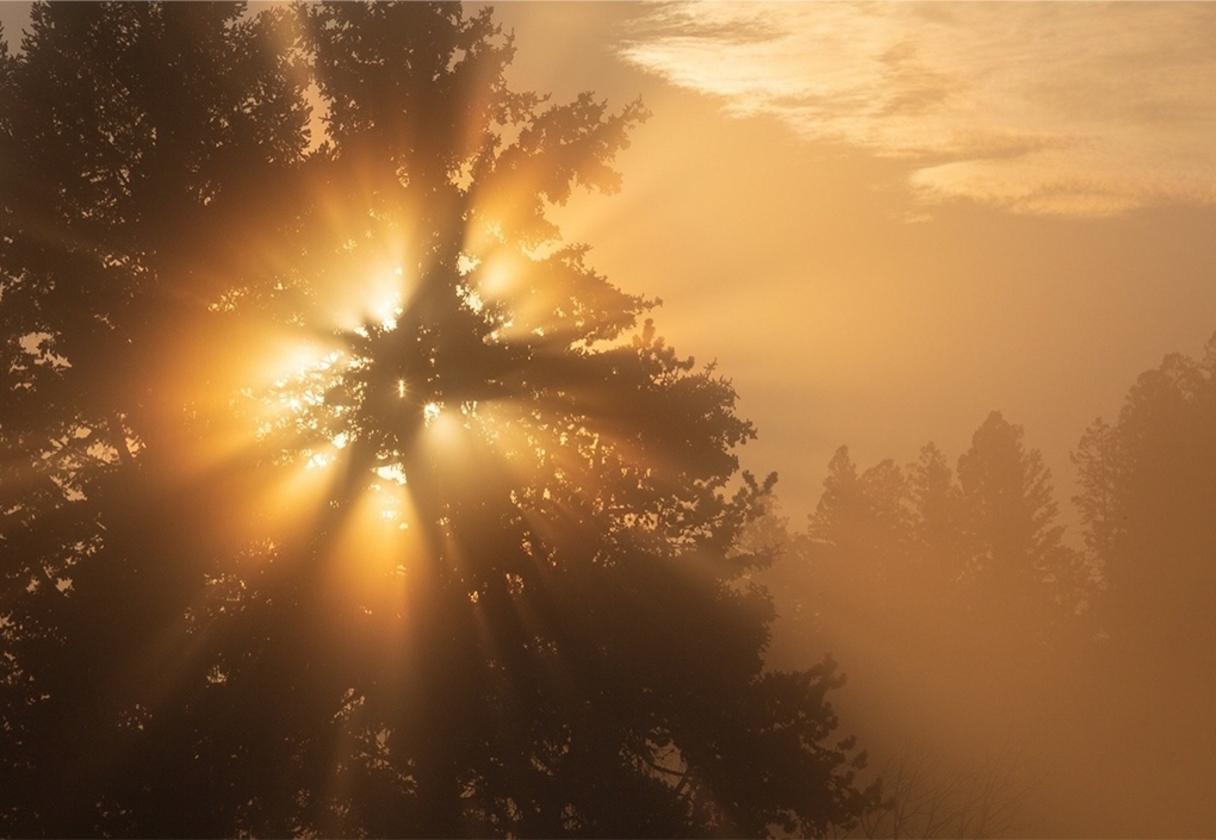Back to StoriesBecoming Bear Aware in the West
June 4, 2025
Becoming Bear Aware in the WestAs state and federal wildlife agencies debate grizzly bear management, nonprofit groups building bear tolerance one trash can at a time
CORRECTION: An earlier version of this story misidentified People and Carnivores Executive Director Lisa Upson as Lori Upson. It also erroneously stated that Kalispell started a bear management program in 2023. Efforts to develop community bear management programs are ongoing in several part of Flathead County, but have not officially begun in Kalispell to date.
by Robert Chaney
A prestige hierarchy of sorts characterizes the three-ring circus of the Interagency Grizzly Bear Committee.
The regional bear managers and biologists are like the lion tamers and acrobats, drawing the most press attention with their tales of captures and maps of population shifts. Public land officials from the U.S. Forest Service and other agencies resemble the strongman performers, slowly lifting and bending heavy policies.
Then comes the Information, Education and Outreach update, when many IGBC audience members make a discrete dash for the restroom or coffee urn. Compared to the latest video of a grizzly bear rolling a trash dumpster into the bushes, a review of the latest public service announcement about electric fencing for chicken coops lags in the ursine charisma department.
And yet, those IEO flyers and small-dollar grants may prove more important to grizzly bear survival than radio collars and culvert traps. After 50 years on the Endangered Species List, the biggest threat to this apex predator remains conflict with people. And the tools with the fastest, cheapest and greatest impact have been information, education and outreach.
“All the talk about delisting and managing what we do with grizzly bears is really about tolerance,” said Evan Stout of Bear Awareness Gardiner, an IGBC-supported organization bear-proofing one of the most grizzly-centric Yellowstone gateway communities. “If you reduce conflicts, that tolerance goes up. People are willing to live with grizzly bears if they’re not a gigantic pain in the butt.”
—
Lewis and Clark first made mainstream America aware of grizzly bears in 1805, largely through journal accounts of how frightening they were and how hard they were to kill. Public perception of grizzlies as a threat to livestock and livelihoods led to federal government programs to shoot or poison the bears off the landscape. During the 19th century settling of the western United States, grizzly bear populations were reduced from tens of thousands to a handful of hundreds.
An estimated 600 grizzlies persisted in the Lower 48 states when they received federal Endangered Species Act protection in 1975. Over the ensuing half-century, that population has increased numerically and geographically.
Today, nearly 1,000 grizzly bears inhabit the Greater Yellowstone Ecosystem, including Yellowstone National Park and a “demographic monitoring area” of occupied habitat surrounding the park. A similar-sized population lives in the Northern Continental Divide Ecosystem, roughly bounded by Kalispell, Missoula and Great Falls.
That’s led to debate between state and federal agencies over who should be responsible when grizzly bears get in trouble. Republicans in Congress, including all the delegations of Montana, Idaho and Wyoming, have called for removing grizzlies from ESA protection and putting state wildlife managers in control.
After 50 years on the Endangered Species List, the biggest threat to this apex predator remains conflict with people.
The Information, Education and Outreach officials talk on a different channel, one much closer to the bears and people. And with varying levels of success, they’ve been busy for years.
“In southwest Montana, we’re hearing more regular reports of bears in those ranges and valleys,” said Matthew Hart of Vital Ground, a Missoula-based grizzly bear conservation group that works closely with the IGBC. “We’ve done partner grants around the GYE for conflict prevention work. The most interesting one is Bear Aware Gardiner - that’s a true gateway community, and that group has done a lot of great work to get bear-proof sanitation going in that community.”
Gardiner’s program got started in 2009, but lapsed as the town’s population churned with newcomers. Stout took it over about five years ago and had to rebuild many of the relationships and outreach efforts.
He followed many of the initiatives that found success in places like Missoula, which has been steadily constructing Bear Aware initiatives for decades. The city government there started developing a bear buffer zone policy in 2010 to limit unsecured garbage in neighborhoods that were seeing heavy black bear activity. That expanded to a bear hazard management plan in 2018 that worked with local garbage hauling companies to distribute bear-resistant cans and other improvements across large parts of Missoula County. Meanwhile, Montana Fish, Wildlife and Parks alongside volunteer organizations helped chicken owners electrify their coops, arranged for gleaning of fruit trees and held workshops in schools and neighborhood organizations on ways to bearproof yards and buildings.
Some places have been slower to respond, including Bozeman which announced Bear Aware offices in 2024. Resort communities like West Yellowstone and Big Sky, located deep in grizzly habitat, have moved quicker. But even though Big Sky launched the Bear Smart Big Sky Council in 2013, it still struggles to keep up with its own development trends.
“It’s human nature to wait until there’s more of a need, but gateway communities like Big Sky know there are grizzlies around,” said People and Carnivores Executive Director Lisa Upson. “Big Sky is tough — people have tried to work there, but there’s so much growth. It’s hard to establish programs in places that are constantly turning over or seasonal.”
The 32-year-old People and Carnivores nonprofit organization works across the Northern Rocky Mountains with the Forest Service and other agencies on programs for food storage, campground safety and outfitter training to reduce wildlife conflicts. Upson said getting people interested in solving problems for their communities has worked better than having some outside group telling everyone what to do.
—
Greater Yellowstone bear managers often deal with smaller but more numerous black bears that are also stretching the bounds of human tolerance. While a run-in with a grizzly can be extremely dangerous, black bears don’t mess around either.
“I never used to lock my car,” recalled Big Sky resident Mel Emery of a fall morning two years ago. She came out to find the door to her Chevy Equinox open, and muddy paw prints all over the vehicle interior. A black bear had figured out how to work the handle.
“Thankfully, the door didn’t shut on it and there wasn’t anything inside to eat,” Emery said. “It’ll destroy your car if it gets trapped inside. I have a friend who that happened to, and it literally totaled the inside of the vehicle. It ripped the seats out and defecated all over it before it figured out it could push out the sunroof. These bears are smart.”
“If you reduce conflicts, that tolerance goes up. People are willing to live with grizzly bears if they’re not a gigantic pain in the butt.” – Evan Stout, Bear Awareness Gardiner
Emery noticed that five or six other cars had evidence of bear probing that morning. She locked her car doors the next night, only to wake up and find the door handle ripped off the car.
The tactics for reducing bear conflicts are well-established: Don’t let bears get accustomed to unnatural attractants like bird feeders, backyard chickens and pet food. It’s getting humans accustomed to following those tactics that tends to be the hard part. After spending years helping the Big Sky community improve its bear conflict situation, wildlife biologist and Bear Smart Big Sky founder Kris Inman found some basic principles helpful.
“I don’t care why people are at the table,” Inman said. “Whether you love bears, are scared of bears, or want to hunt bears, we all have a responsibility to not attract bears. Some people try to change everyone’s mind. I don’t care. If you want the behavior to change, it doesn’t matter why you’re there.”
Following that principle moved Big Sky from a 30-percent voluntary use of bear-resistant trash cans when Inman started in 2012 to nearly 80 percent when she left for Alaska in 2021. Education programs targeted resort employees, who learned to use bear spray and other methods for staying safe in the bear country that was their literal backyards.
In Gardiner, Stout helped a local welder get IGBC-approved to build commercial-sized dumpsters for restaurants and hotels. That cut the typical cost from around $8,000 down to about $3,000, making it much easier to set up cost-share agreements that businesses can afford. Bear Awareness Gardiner has also helped residents protect beehives and chicken coops with electric fencing, and organized the local Future Farmers of America students to glean fruit trees every August.
But it remains an uphill struggle convincing new residents to pay attention to the old bear problems.
“Bears are moving around more,” Upson said. “I’m worried Bozeman will have a grizzly encounter on the Sourdough Trail or up at Mystic Lake and they’re going to want to do something and it will be too late. Cities like Kalispell and the surrounding area already have grizzly bears moving around. And with every new house, vehicle and hiker, there are tenfold more attractants on the landscape in different places.”
—
Sometimes a slow accretion of change brings results. Sometimes, a specific event can trigger an avalanche of response.
“I think the death of 399 has catalyzed Jackson Hole,” Upson said, referring to the accidental killing of the world-famous Grand Teton National Park grizzly by a motorist last fall. “Now there’s more attention to vehicle collisions that I hadn’t seen before. Probably 399 has motivated them to do more.”
That highlights a different problem in the IEO mission: Full-time residents and have different needs and responsibilities than tourists.
“We mostly work with out-of-area visitors who want security in the backcountry that isn’t harmful to the bears,” said Noah Weinstein with the Bear Aware Bear Spray Rental Network and Teton Backcountry Rentals in Jackson Hole. The program has also found fans among the seasonal workers in Grand Teton and Yellowstone national parks. That’s resulted in new partners extending north to Old Faithful, Bozeman and Belgrade.
“Whether you love bears, are scared of bears, or want to hunt bears, we all have a responsibility to not attract bears." – Kris Inman, wildlife biologist, launched Bear Smart Big Sky Council
So bear education programs have one tool kit for residents, and a different one for visitors. The conservation organization Vital Ground has long-term programs to acquire critical habitat for grizzlies and support range riders and carcass collection to reduce rancher/grizzly conflicts in the Gravelly and Centennial mountain ranges.
“And we also do bear spray outreach and print informational brochures for VRBOs in Ennis,” said Vital Ground’s Hart. “The occupied range maps are creeping out, especially south into Wyoming. People worried how that would play out if grizzlies are no longer listed.”
The governments of Montana, Wyoming and Idaho have all called on the federal government to delist grizzlies from the Endangered Species Act and turn the bears over to state control. In January, the U.S. Fish and Wildlife Service denied those requests and proposed a new federal rule keeping grizzlies protected but allowing more local management flexibility.
“Bears in human-dominated areas affect people’s social tolerance,” said IGBC Coordinator David Diamond. “We want to keep working lands working, keep communities safe and make it so bears can move through. People are stepping up to find resources to do the work.”
__________________________________________________________________________________________________
Mountain Journal is a nonprofit, public-interest journalism organization dedicated to covering the wildlife and wild lands of Greater Yellowstone. We take pride in our work, yet to keep bold, independent journalism free, we need the support of readers like you. Thank you.
Related Stories
April 3, 2024
If Grizzlies Delisted, Here's What Montana Plans to do
Is the Treasure State’s proposed Grizzly Bear Management Plan really a grizzly hunting plan?
March 4, 2025
Will Federal Freeze Stymie Wildland Fire Fights?
Delays in hiring crews and funding hazardous fuels projects worry officials as the 2025 fire season approaches.
April 3, 2025
Montana Updates Wolf Management Playbook as Hunting Bills Advance
Wildlife managers release first wolf management plan in 22 years, set minimum baseline population to 450.





